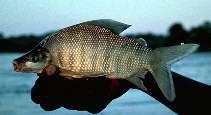| Family: |
Distichodontidae (Distichodus) |
| Max. size: |
57 cm SL (male/unsexed); max.weight: 7,555.0 g |
| Environment: |
pelagic; freshwater |
| Distribution: |
Africa: Middle and Lower Zambezi, including Lake Kariba, and Pungwe and Buzi rivers in Mozambique (Ref. 52193). Reports from Congo River basin refer to other species of Distichodus (Ref. 96324, 122092). |
| Diagnosis: |
Dorsal spines (total): 0-0; Dorsal soft rays (total): 27-29; Anal spines: 0-0; Anal soft rays: 14-15. Diagnosis: snout extended; mouth terminal; head about 4 times in fork length; juveniles with 6-7 dark bars (Ref. 52193).
Description: scales ctenoid, 67—70 in lateral line; body deep and compressed; adipose fin with scales, caudal deeply forked, largely covered by scales; head depressed, nape rising steeply with concave predorsal profile; mouth terminal; 2 rows of bicuspid teeth; dorsal fin with 4 unbranched and 19-23 branched rays; anal fin with 3-4 unbranched and 10-12 branched rays (Ref. 52193).
Coloration: adults deep olive, almost black; juveniles silvery, with 6—7 broad vertical dark bars (Ref. 52193). |
| Biology: |
Inhabits swift flowing water, rapids or quiet, deep, sandy or rocky pools (Ref. 13337). Found only in the mainstream of larger rivers and even in Lake Kariba prefers more riverine habitats; omnivorous, feeds on insects, snails, small fish, and aquatic plants; breeds in summer, moving upstream to suitable sites (Ref. 7248, 52193). |
| IUCN Red List Status: |
Least Concern (LC); Date assessed: 01 May 2009 Ref. (130435)
|
| Threat to humans: |
harmless |
Source and more info: www.fishbase.org. For personal, classroom, and other internal use only. Not for publication.

